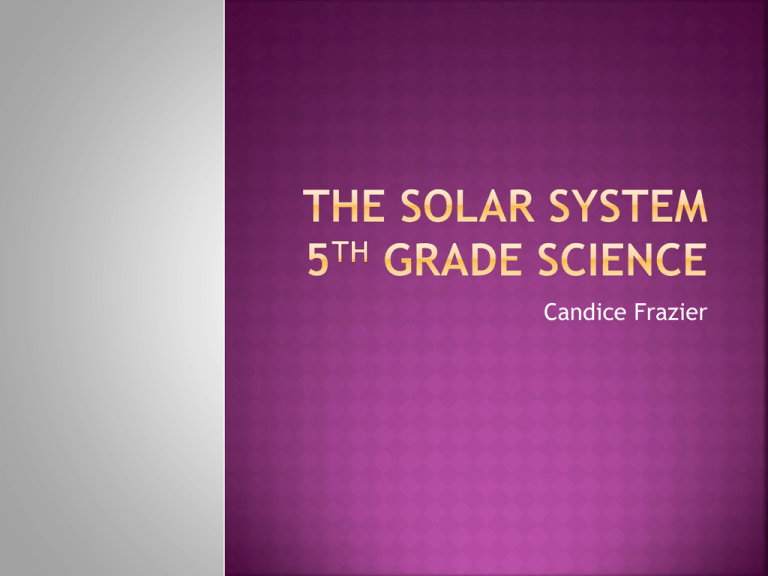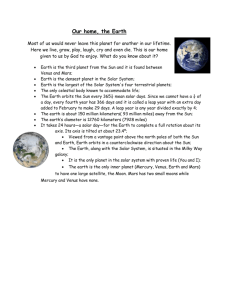The Solar System assign 5
advertisement

Candice Frazier §112.7. Science, Grade 5 (4)Science is a way of learning about the natural world. Students should know how science has built a vast body of changing and increasing knowledge described by physical, mathematical, and conceptual models. (8) Earth and space. The student knows that there are recognizable patterns in the natural world and among the Sun, Earth, and Moon system. The student is expected to: (A) differentiate between weather and climate; (B) explain how the Sun and the ocean interact in the water cycle; (C) demonstrate that Earth rotates on its axis once approximately every 24 hours causing the day/night cycle and the apparent movement of the Sun across the sky; and (D) identify and compare the physical characteristics of the Sun, Earth, and Moon. I will be teaching 5th graders about the solar system. Going into this, I know that the solar system is a challenging topic so I will do my best to make it fun I will use different methods to teach them about the solar system: Activities, Computer learning games, and lectures. The four planets closest to the sun— Mercury, Venus, Earth, and Mars—are called the terrestrial planets because they have solid rocky surfaces. The four large planets beyond the orbit of Mars— Jupiter, Saturn, Uranus, and Neptune—are called gas giants. The planet Mercury is the closest of the planets to the Sun. Because this planet lies so close to the Sun, and as a result somewhat near to the Earth, it is visible to observers on Earth in the night time sky. Because of this, Mercury has become apart of the mythology and legend of almost every culture throughout the history of the Earth. This planet is often called a morning star. This is because Mercury shines brightly in the early morning, just before the sun rises. It has also been called an evening star for the same reason. Mercury often is visible for a brief period of time just after the Sun sets. The planet Venus has long been one of the most misunderstood of all the inner planets. Like the Earth, Venus has an atmosphere. However, this atmosphere is far thicker than that of the Earth, making it difficult for modern science to penetrate. Because we cannot see the surface of the planet Venus visually, there is much we still do not know about how this planet looks, and what it is like. However, using special instruments and probes scientists have in recent years unlocked many of the secrets long hidden by this mysterious world. Mars excites scientists because its mild temperament is more like the Earth's than any of the other planets. Evidence suggests that Mars once had rivers, streams, lakes, and even an ocean. As Mars' atmosphere slowly depleted into outer space the surface water began to permanently evaporate. Today the only water on Mars is either frozen in the polar caps, or underground. Continue with the rest of the planets and information about them. Have students go to the website: http://www.kidsastronomy.com/fun/orbitsV3 .swf They will be able to build their own Solar System there. Have Students go to the website: http://www.kidsastronomy.com/solar_syste m.htm There, they will be able to click on the different planets and it will bring up an endless source of information about the different planets, along with the solar system itself. Games included on the website Supplies needed: A round piece of cardboard about 1 ft across (the cardboard from a frozen pizza works well) Lots of colors of oak tag (or construction paper) Scissors Tape String Pencil, crayons, or markers A compass (for making circles) Have them write a paper about the Solar System. They can pick one planet to specifically write about. List the planets in order. Have a class discussion on what they learned overall about the Solar System. Go over the Solar System Model they made and the different websites that taught them about the Solar System and discuss what they gained from all the activities. http://science.nationalgeographic.com/scie nce/space/solar-system http://www.kidsastronomy.com/fun/orbitsV3 .swf http://www.kidsastronomy.com/solar_syste m.htm http://www.enchantedlearning.com/crafts/a stronomy/solarsystemmodel/






